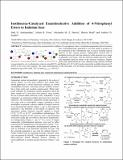Files in this item
Isothiourea-catalyzed enantioselective addition of 4-nitrophenyl esters to iminium ions
Item metadata
| dc.contributor.author | Arokianathar, Jude N. | |
| dc.contributor.author | Frost, Aileen B. | |
| dc.contributor.author | Slawin, Alexandra M. Z. | |
| dc.contributor.author | Stead, Darren | |
| dc.contributor.author | Smith, Andrew D. | |
| dc.date.accessioned | 2018-12-12T00:36:28Z | |
| dc.date.available | 2018-12-12T00:36:28Z | |
| dc.date.issued | 2018-02-02 | |
| dc.identifier | 251746585 | |
| dc.identifier | 67097555-a22d-49a2-b998-ac79617e7221 | |
| dc.identifier | 85041483624 | |
| dc.identifier | 000424735000051 | |
| dc.identifier.citation | Arokianathar , J N , Frost , A B , Slawin , A M Z , Stead , D & Smith , A D 2018 , ' Isothiourea-catalyzed enantioselective addition of 4-nitrophenyl esters to iminium ions ' , ACS Catalysis , vol. 8 , no. 2 , pp. 1153-1160 . https://doi.org/10.1021/acscatal.7b02697 | en |
| dc.identifier.issn | 2155-5435 | |
| dc.identifier.other | ORCID: /0000-0002-2104-7313/work/39714949 | |
| dc.identifier.other | ORCID: /0000-0002-9527-6418/work/56861715 | |
| dc.identifier.uri | https://hdl.handle.net/10023/16668 | |
| dc.description | The authors thank AstraZeneca and the EPSRC (grant codes EP/M506631/1; J.N.A. and EP/J018139/1; A.B.F.) for funding. The European Research Council under the European Union’s Seventh Framework Programme (FP7/2007-2013) ERC Grant Agreement No. 279850 is also acknowledged. A.D.S. thanks the Royal Society for a Wolfson Research Merit Award. | en |
| dc.description.abstract | Isothioureas catalyze the enantioselective addition of 4-nitrophenyl esters to tetrahydroisoquinoline-derived iminium ions. 4-Nitrophenoxide, generated in situ from initial N-acylation of the isothiourea by the 4-nitrophenyl ester, is used to facilitate catalyst turnover in this reaction process. Optimization showed that 4-nitrophenyl esters give the best reactivity in this protocol over a range of alternative aryl esters, with the observed enantioselectivity markedly dependent upon the nature of the iminium counteri-on. Highest yields and enantioselectivity were obtained using iminium bromide ions generated in situ via photoredox catalysis using BrCCl3 and Ru(bpy)3Cl2 (0.5 mol%) and commercially available tetramisole (5 mol%) as the Lewis base catalyst. The scope and limitations of this procedure was developed, giving the desired β-amino amide products in up to 96% yield, 79:21 dr and ermajor (2R,1′S) 99.5:0.5. | |
| dc.format.extent | 1264417 | |
| dc.language.iso | eng | |
| dc.relation.ispartof | ACS Catalysis | en |
| dc.subject | QD Chemistry | en |
| dc.subject | DAS | en |
| dc.subject.lcc | QD | en |
| dc.title | Isothiourea-catalyzed enantioselective addition of 4-nitrophenyl esters to iminium ions | en |
| dc.type | Journal article | en |
| dc.contributor.sponsor | EPSRC | en |
| dc.contributor.sponsor | EPSRC | en |
| dc.contributor.sponsor | European Commission | en |
| dc.contributor.sponsor | The Royal Society | en |
| dc.contributor.institution | University of St Andrews. School of Chemistry | en |
| dc.contributor.institution | University of St Andrews. EaSTCHEM | en |
| dc.contributor.institution | University of St Andrews. Biomedical Sciences Research Complex | en |
| dc.identifier.doi | 10.1021/acscatal.7b02697 | |
| dc.description.status | Peer reviewed | en |
| dc.date.embargoedUntil | 2018-12-12 | |
| dc.identifier.grantnumber | EP/J018139/1 | en |
| dc.identifier.grantnumber | EP/J018139/1 | en |
| dc.identifier.grantnumber | N/A | en |
| dc.identifier.grantnumber | WM140071 | en |
This item appears in the following Collection(s)
Items in the St Andrews Research Repository are protected by copyright, with all rights reserved, unless otherwise indicated.

